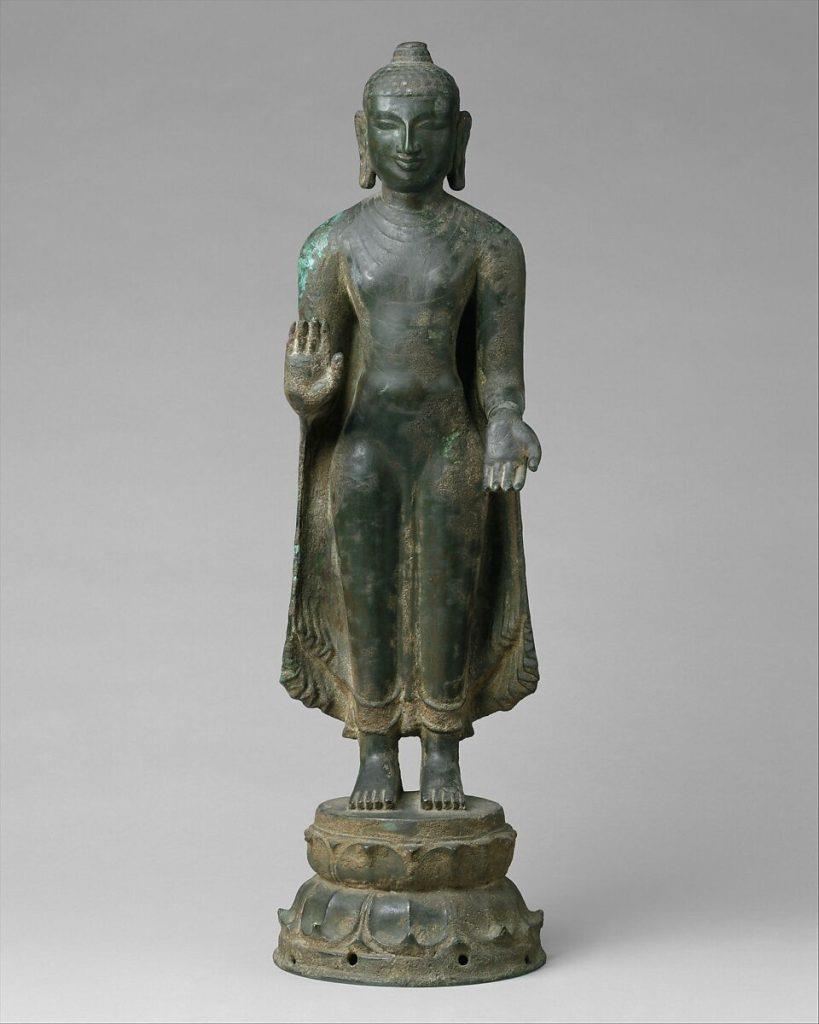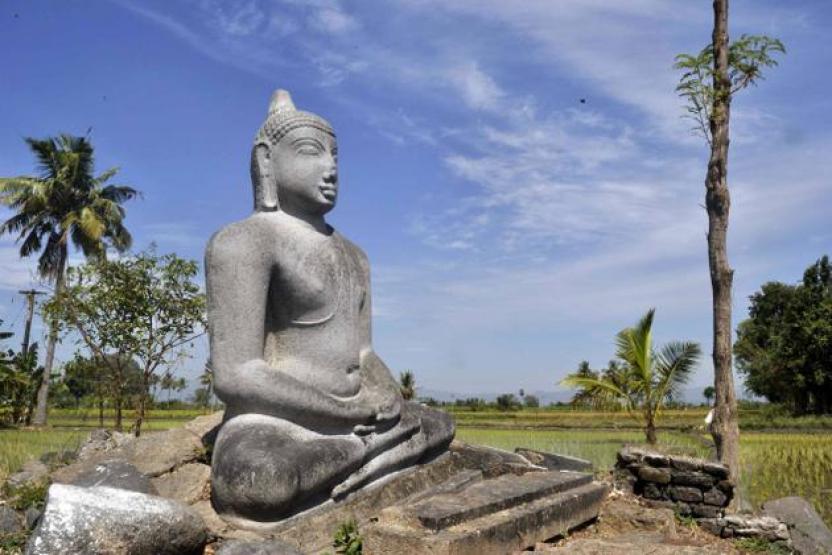
Nagapattinam Was A Major Centre Of Buddhism In South India
Colombo, May 7: The passenger ferry service between Nagapattinam in Tami Nadu and Kankesanthurai (KKS) near Jaffna, which was launched in October 2023, will resume on May 13, the Indian High Commission in Colombo has said.
Sri Lankan Buddhists would be interested to know that Nagapattinam was among the first and the last centres of Buddhism in South India. Even now, there are places like Sangamangalam, Buddhamangalam and Putthakkudy around Nagapattinam, as a reminder of the region's Buddhist past.
ADVERTISEMENTNagapattinam was a major port city of the medieval Chola kingdom (9 th. to the 13 th AD) with maritime trade links with many East Asian countries. Stone and clay statues of the Buddha from the 2nd Century AD and the remains of monasteries were found in Poompuhar, a nearby town.
According to the Pallava king Narasimhavarman II (7th to 8th AD) built a Buddha Vihara at Nagapattinam. The Chudamani Vihara in Nagapattinam was constructed by the Srivijayan king Sri Mara Vijayattungavarman of the Sailendra dynasty with the help of Rajaraja Chola I.
About 350 bronze statues have been unearthed in Nagapattinam. The bronze statues found in Nagapattinam belong to various periods between 9th and the 17th Century AD. Around Nagapattinam, there are also many ancient stone statues of the Buddha (dated between 8th and 10th Century AD) in places such as Pushpavanam, Peruncheri, Buddhamangalam etc. From these names it can be inferred that Mahayana Buddhism thrived in Nagapattinam till 17th Century AD,” says.
Before the ascendance of Saivism and Vaishnavism in Tamil Nadu, Buddhism and Jainism prevailed there. Nagapattinam and Kanchipuram were the main centres of these religions.
At that time, artisans of Nagapattinam produced metal figures of Buddhist and Jain deities besides Hindu gods. This was so till the 13th century. Transient merchants and pilgrims from Sri Lanka, Southeast Asia, and China patronised the religious and artistic activities in Nagapattinam.
Portable bronze figures of the Buddha were carried by these itinerant communities to South East and East Asia.
In an article in The Hindu, S described some of the masterpieces found in Nagapattinam.“There is a Buddha sculpture in metal only 52 cm tall. It is a masterpiece in the detail it contains. The Buddha is seated on a throne, his right hand in the upadesa mudra and an umbrella high above his head. An ushnisha
(flame of knowledge) is prominent on his head and the creepers around the umbrella signify the Bodhi tree.”

Buddha offering protection. Nagapattinam
“Around the Buddha, in the outer row, is a full“orchestra” - several men are playing the lute and other stringed instruments, a couple of them are playing percussion instruments like the mridangam and there is also a rasika with his hand stretched out and enjoying the music.”
Buddhism came to South India in the Second Century BC, before the third Sangam period (Third Century BC to Third Century AD). Dr. Nirmala Chandrahasan quotes from Hisselle Dharmaratana Maha Thera's Buddhism in South India to say that there is evidence that Ven. Mahinda Thera, Emperor Asoka's son, had spread Buddhism in Tamil Nadu.
Dharmaratna Maha Thera says:“Although the chronicles say he arrived through his supernatural powers, scholars are of the opinion that he travelled by sea and called at Kaveripattinam on the east coast of Tamil Nadu on his way to Sri Lanka.”
Dr Hikosaka, Director Professor of Buddhism, Institute of Asian Studies in Madras, in his book Buddhism in Tamil Nadu a new perspective' shares Dharmartna Thera's view.
Hsuan Tsang, the 7th Century Chinese Buddhist monk and traveller, mentions that in the Pandyan kingdom at Madurai, there was a monastery built by Mahinda Thera. He also mentions a stupa built by King Asoka in Kanchipuram. Stone inscriptions of Emperor Asoka (Rock Edict no 3) refer to the Dhamma being spread in the Chola and Pandya country in Tamil Nadu besides Sri Lanka.
Dr. Chandrahasan says that Buddhism flourished in Tamil Nadu in two phases, firstly in the early years of the Pallava rule (400 AD to 650 AD), and secondly in the Chola period mid-9th to the early 14th century AD. There were many centres of Buddhism in Tamil Nadu. Among them were Nagapattinam, Kanchipuram, Kaveripattinam and Uraiyur.
Hsuan Tsang describes Kanchipuram near Chennai as a flourishing city and states that most of its population was Buddhist. He also says that there were over 100 Buddhist monasteries and over a thousand Buddhist monks there. He mentions the presence of 300 monks from Sri Lanka in the monastery in the Southern part of Kanchipuram.

Buddha in meditation, Nagapattinam
The Pallava king Mahendra Varman in his Sanskrit work Mattavilasa Prahasana refers to the existence of many Buddhist Viharas, chief of which was the Raja Vihara in his domain.
“The interaction between Tamil Nadu monks and Sri Lankan monks is mentioned in the Manimakalai, the 6th Century Tamil literary epic written by Sattanar,” Dr. Chandrahsan points out.
Among the other Tamil literary epics which show the influence of Buddhism are the Silappadhihkaram' 'Valaiyapathi Kundalakesi' and 'Jivaka Cintamani.
Dr. Hikosaka points out that during the Pallava period Tamil Nadu (275 AD to 897 AD) there were outstanding Tamil Buddhist monks who made remarkable contributions to Buddhist thought and learning. Dr mentions Buddhadatte Thera who authored many books. In the Abhidhammaratana, he gives a glowing account of Kaveripattinam and Kanchipuram and the Mahavihara in Sri Lanka.
When Buddhadatta Thera was in Sri Lanka, he composed many Buddhist works such as Uttara Viniccaya, Ruparupa Vibhaga and Jinalankara.
Another famous Tamil monk Dr,Chandrahasan mentions, is Buddhaghosha, a contemporary of Bhuddhadatta. He made a remarkable contribution to Buddhism in Sri Lanka. He stayed and studied Buddhist precepts at the Maha Vihara at Anuradhapura.

KKS-Nagapattinam map
“The Visuddimagga was the first work of Buddhaghosha while in Sri Lanka. While staying at the Granthakara Pirivena at Anuradhapura, he rendered Sinhalese commentaries of the Tripitakas into Pali.”
Dhammapala was another Tamil monk mentioned by Dr. Hikosaka.“The study of the three monks shows that Tamil Nadu Buddhists were closely associated with Sri Lankan Buddhists. It will be noticed that the monks used the Pali language in their treatises just as in Europe in the middle ages, the Christian monks used Latin,” Dr points out.
Dr. Chandrahasan argues that since Tamil Nadu was largely Buddhist, one could easily conclude that the Tamil population in the North and East of Sri Lanka was also largely Buddhist. The Tamil Buddhists who followed Theravada Buddhism shared common places of worship with the Sinhalese.
There were also Tamil Buddhists who were followers of Mahayana Buddhism, and these had their own Mahayana temples, she adds.
END

Legal Disclaimer:
MENAFN provides the
information “as is” without warranty of any kind. We do not accept
any responsibility or liability for the accuracy, content, images,
videos, licenses, completeness, legality, or reliability of the information
contained in this article. If you have any complaints or copyright
issues related to this article, kindly contact the provider above.


















Comments
No comment